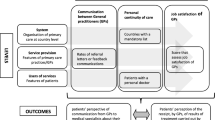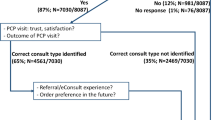Abstract
Despite the common use of electronic communication in other aspects of everyday life, its use between patients and health care providers has been slow to diffuse. Possible explanations are security issues and lack of payment mechanisms. This study investigated how patients value secure electronic access to their general practitioner (GP). One hundred and ninety-nine patients were asked an open-ended willingness-to-pay (WTP) question as part of a randomised controlled trial. We compared the WTP values between two groups of respondents; one group had had the opportunity to communicate electronically with their GP for a year and the other group had not. Fifty-two percent of the total sample was willing to pay for electronic GP contact. The group of patients with access revealed a significantly lower WTP than the group without such access. Possible explanations are that the system had fewer benefits than expected, a presence of hypothetical bias or simply a preference for face-to-face encounters.

Similar content being viewed by others
Notes
We also analysed the income adjusted for household size using Organisation for Economic Co-operation and Development (OECD) weights both in the logistic regression and the correlation analysis. We found no differences in the results when household-size-adjusted income was used as predictor variable.
References
Katz, S.J., Moyer, C.A.: The emerging role of online communication between patients and their providers. J Gen Intern Med 19, 978–983 (2004)
Moyer, C.A., Stern, D.T., Dobias, K.S., Cox, D.T., Katz, S.J.: Bridging the electronic divide: patient and provider perspectives on e-mail communication in primary care. Am. J. Manag. Care 8, 427–33 (2002)
Harris, Interactive/ARiA (2000): Marketing healthcare satisfaction study. Rochester, Atlanta: Harris Interactive, ARiA Marketing (http://www.harrisinteractive.com/news/downloads/HarrisAriaHCSatRpt.PDF, accessed Oct 2005)
Kleiner, K.D., Akers, R., Burke, B.L., Werner, E.J.: Parent and physician attitudes regarding electronic communication in pediatric practices. Pediatrics 109, 740–744 (2002)
Sittig, D.F., King, S., Hazlehurst, B.L.: A survey of patient-provider e-mail communication: what do patients think? Int. J. Med. Inform. 61, 71–80 (2001)
Couchman, G.R., Forjuoh, S.N., Rascoe, T.G.: E-mail communications in family practice: what do patients expect? J. Fam. Pract. 50, 414–418 (2001)
Fridsma, D.B., Ford, P., Altman, R.: A survey of patient access to electronic mail: attitudes, barriers and opportunities. Proceedings of the annual symposium on computer application in medical care 15–19 (1994)
Andreassen, H., Sandaune, A-G., Gammon, D., Hjortdahl, P.: Use of internet health services in Norway. Tidsskr. Nor. Laegeforen. 122, 1640–1644 (2002)
Hassol, A., Walker, J.M., Kidder, D., et al.: Patient experience and attitude about access to a patient electronic health care record and linked web messaging. J. Am. Med. Inform. Assoc. 11, 505–513 (2004)
White, C.B., Moyer, C.A., Stern, D.T., Katz, S.J.: A content analysis of e-mail communication between patients and their providers: patients get the message. J. Am. Med. Inform. Assoc. 11, 260–267 (2004)
Houston, K.T., Sands, D.Z., Jenckes, M.W., Ford, D.E.: Experiences of patients who where early adoptersof electronic communication with their physician: satisfaction, benefits and concerns. Am. J. Manage. Care. 10, 601–608 (2004)
Sittig, D.F.: Result of a content analysis of electronic messages (e-mail) sent between patients and their physicians. BMC Med. Inform. Decis. Mak. 3(1), 11 (2003)
Anand, S.G., Feldman, M.J., Geller, D.S., Bisbee, A., Bauchner H.: A content analysis of e-mail communication between primary care providers and parents. Pediatrics 115, 1283–1288 (2005)
Bergmo, T.S., Kummervold, P.E., Gammon, D., Dahl, L.B.: Electronic patient-provider communication: will it offset office visits and telephone consultation in primary care? Int. J. Med. Inform. 74(9), 705–710 (2005)
Car, J., Sheikh, A.: E-mail consultation in health care: 2-acceptability and safe application. BMJ 329, 439–442 (2004)
Mitchell, R., Carson, R.: Using surveys to value public goods: the contingent valuation method. Hopkins University Press, Washington DC (1989)
Olsen, J.A., Smith, R.D.: Theory versus practice: a review in ‘willingness-to-pay’ in health and health care. Health Econ. 10, 39–52 (2001)
Smith, R.D.: Construction of the contingent valuation market in health care: a critical assessment. Health Econ. 12, 609–628 (2003)
Diener, A., O’Brien, B, Gafni, A.: Health care contingent valuation studies: a review and classification of the literature. Health Econ. 74, 313–326 (1998)
Tversky, A., Kahneman, D.: Judgment under uncertainty: heuristics and biases. Science 185, 1124–1131 (1974)
van Exel, N.J.A., Brouwer, W.B.F., van den Berg, B., Koopmanschap, M.A.: With a little help from an anchor: Discussion and evidence of anchoring effects in contingent valuation. J Soc-Econ (in press), corrected proof (2006)
Kummervold, P.E., Trondsen, M., Andreassen, H., Gammon, D., Hjortdahl, P.: Patient–physician interaction over the internet. Tidssk. Nor. Laegeforen. 124, 2633–2636 (2004)
Norwegian Centre for Telemedicine. PatientLink—project information http://www.telemed.no/index.php?language=en&cat=7457 (accessed January 2006)
Peeters, G., Czapinski, J.: Positive-negative asymmetry in evaluations: the distinction between affective and informational negativity effects. Eur. Rev. Social Psychol 1, 33–60 (1990)
Smith, R.D.: It’s not just what you do, it’s the way that you do it: the effect of different payment card formats and survey administration on willingness to pay for health gain. Health Econ.15(3), 281–293 (2006)
Whynes, D.K., Frew, E., Wolstenholme, J.L.: A comparison of two methods for eliciting contingent valuations of collateral cancer screening. J. Health Econ. 22, 555–574 (2003)
Whynes, D.K., Philips, Z., Frew, E.: Think of a number ...any number? Health Econ. 14, 1191–1195 (2005)
Biemer, P.P., Lyberg, L.E.: Introduction to Survey Quality. Wiley, Hoboken (2003)
Campanelli P.: Methods for testing and evaluating survey questionnaires. J. R. Stat. Soc. Ser. A Stat. Soc. 168(3), 637–637 (2005)
Schkade, D.A., Payne, J.W.: How people respond to contingent valuation questions: a verbal protocol analysis of willingness to pay for an environmental regulation. J. Environ. Econ. Manage. 26(1), 88–109 (1994)
Shiell, A., Gold, L.: If the price is right: vagueness and values clarification in contingent valuation. Health Econ. 12(11), 909–919 (2003)
Acknowledgments
We thank Jan Abel Olsen, Per Egil Kummervold, an anonymous referee and all the patients and GPs at Sentrum Legekontor for their participation in this study. The authors have no conflicts of interest relevant to the content of this study.
Author information
Authors and Affiliations
Corresponding author
Rights and permissions
About this article
Cite this article
Bergmo, T.S., Wangberg, S.C. Patients’ willingness to pay for electronic communication with their general practitioner. Eur J Health Econ 8, 105–110 (2007). https://doi.org/10.1007/s10198-006-0014-5
Received:
Accepted:
Published:
Issue Date:
DOI: https://doi.org/10.1007/s10198-006-0014-5




